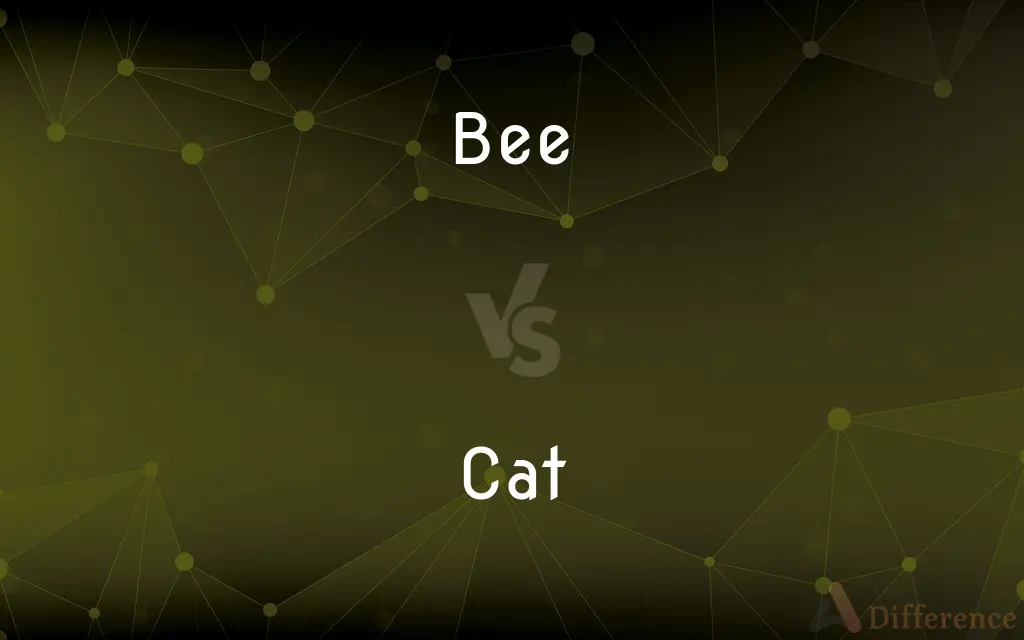Bee vs. Cat — What's the Difference?
By Urooj Arif & Fiza Rafique — Updated on March 28, 2024
Bees are insects known for pollination and honey production, while cats are mammals appreciated as pets for their companionship and hunting abilities.

Difference Between Bee and Cat
Table of Contents
ADVERTISEMENT
Key Differences
Bees are small, flying insects that play a crucial role in pollination, supporting the growth of many plants and crops. They are social creatures, living in colonies with a structured hierarchy. Whereas, cats are domesticated mammals known for their agility, hunting skills, and role as companions in many households. They are solitary by nature but can form strong bonds with humans and other animals.
Bees produce honey from the nectar of flowers, a process that is vital for their colonies' survival through winter. This substance is also valued by humans for its sweetness and health benefits. On the other hand, cats are carnivorous animals that require a diet rich in protein, often satisfied through commercial pet food or through their natural hunting instincts.
Bees communicate with each other through dances and pheromones, a sophisticated system that allows them to convey information about food sources and dangers. In contrast, cats communicate with humans and other animals through a combination of vocalizations, body language, and scent marking, showcasing their emotional state and territorial claims.
The lifecycle of a bee is fascinating, starting from an egg to becoming a larva, then a pupa, and finally emerging as an adult. Each stage has its unique requirements and duration. Cats, however, go through a simpler developmental process, from a kitten to an adult, with significant growth and behavioral changes occurring in the first year.
Bees are vital for the environment, contributing to the pollination of flowers, which is essential for the reproduction of many plants. Cats contribute to the environment by controlling the population of small pests, such as mice and rats, but they can also pose a threat to local wildlife if not kept indoors or monitored.
ADVERTISEMENT
Comparison Chart
Kingdom
Animalia
Animalia
Class
Insecta
Mammalia
Diet
Nectar and Pollen
Carnivorous
Social Structure
Colony-based, with a queen, workers, and drones
Solitary or small family groups, often living with humans
Role in Ecosystem
Pollination, supporting plant growth and reproduction
Pest control, companionship
Compare with Definitions
Bee
Pollinators.
As pollinators, bees play a crucial role in the ecosystem and agriculture.
Cat
Mammal.
A cat is a mammal often kept as a pet for companionship.
Bee
Colony Living.
Bees live in colonies consisting of thousands of individuals working together.
Cat
Carnivorous Diet.
Cats are carnivores, requiring a diet rich in meat.
Bee
Communication.
Bees communicate through dances and pheromones to share information.
Cat
Solitary.
Although cats can enjoy companionship, they are generally more solitary than dogs.
Bee
Insect.
A bee is an insect known for its role in pollination and honey production.
Cat
Communication.
Cats communicate with humans through meows, purrs, and body language.
Bee
Honey Producers.
Bees produce honey from the nectar of flowers, which is used as food by them and humans.
Cat
Hunters.
Cats are natural hunters, often chasing small animals like birds and mice.
Bee
Bees are insects with wings closely related to wasps and ants, known for their role in pollination and, in the case of the best-known bee species, the western honey bee, for producing honey. Bees are a monophyletic lineage within the superfamily Apoidea.
Cat
The cat (Felis catus) is a domestic species of small carnivorous mammal. It is the only domesticated species in the family Felidae and is often referred to as the domestic cat to distinguish it from the wild members of the family.
Bee
Any of numerous winged, hairy-bodied, usually stinging hymenopteran insects of the superfamily Apoidea, including both solitary species and social species such as the honeybees, and characterized by sucking and chewing mouthparts for gathering nectar and pollen.
Cat
A small domesticated carnivorous mammal (Felis catus), kept as a pet and as catcher of vermin, and existing in a variety of breeds.
Bee
A gathering that combines cooperative labor and social interaction or friendly competition
A quilting bee.
Cat
Any of various other carnivorous mammals of the family Felidae, including the lion, tiger, leopard, and lynx.
Bee
A competition in which contestants are eliminated one by one after failing to answer a question or solve a problem
A spelling bee.
Cat
(Informal) A woman who is regarded as spiteful.
Bee
A bee block.
Cat
A person, especially a man.
Bee
The letter b.
Cat
A player or devotee of jazz music.
Bee
A flying insect, of the clade Anthophila within the hymenopteran superfamily Apoidea, known for its organised societies (though only a minority have them), for collecting pollen and (in some species) producing wax and honey.
Cat
A cat-o'-nine-tails.
Bee
A contest, especially for spelling; see spelling bee.
Geography bee
Cat
A catfish.
Bee
A community gathering to share labour, e.g. a sewing bee or a quilting bee.
Cat
A cathead.
Bee
(obsolete) A ring or torque; a bracelet.
Cat
A device for raising an anchor to the cathead.
Bee
Any of the pieces of hard wood bolted to the sides of the bowsprit, to reeve the fore-topmast stays through.
Cat
A catboat.
Bee
Obsolete spelling of be
Cat
A catamaran.
Bee
(obsolete) be; been
Cride out, Now now Sir knight, shew what ye bee,
Cat
To hoist an anchor to (the cathead).
Bee
An insect of the order Hymenoptera, and family Apidæ (the honeybees), or family Andrenidæ (the solitary bees.) See Honeybee.
Cat
An animal of the family Felidae:
Bee
A neighborly gathering of people who engage in united labor for the benefit of an individual or family; as, a quilting bee; a husking bee; a raising bee.
The cellar . . . was dug by a bee in a single day.
Cat
A domesticated species (Felis catus) of feline animal, commonly kept as a house pet.
Bee
Pieces of hard wood bolted to the sides of the bowsprit, to reeve the fore-topmast stays through; - called also bee blocks.
Cat
Any similar animal of the family Felidae, which includes lions, tigers, bobcats, leopards, cougars, cheetahs, caracals, lynxes, and other such non-domesticated species.
Bee
Any of numerous hairy-bodied insects including social and solitary species
Cat
A person:
Bee
A social gathering to carry out some communal task or to hold competitions
Cat
(offensive) A spiteful or angry woman.
Cat
An enthusiast or player of jazz.
Cat
(slang) A person (usually male).
Cat
(slang) A prostitute.
Cat
(nautical) A strong tackle used to hoist an anchor to the cathead of a ship.
Cat
Short form of cat-o'-nine-tails.
Cat
(archaic) A sturdy merchant sailing vessel now only in "catboat".
Cat
The game of "trap and ball" (also called "cat and dog").
Cat
The trap of the game of "trap and ball".
Cat
(archaic) The pointed piece of wood that is struck in the game of tipcat.
Cat
A double tripod (for holding a plate, etc.) with six feet, of which three rest on the ground, in whatever position it is placed.
Cat
(historical) A wheeled shelter, used in the Middle Ages as a siege weapon to allow assailants to approach enemy defences.
Cat
(computing) A program and command in Unix that reads one or more files and directs their content to the standard output.
Cat
(slang) A street name of the drug methcathinone.
Cat
Abbreviation of catapult
A carrier's bow cats
Cat
Abbreviation of catalytic converter
Cat
Abbreviation of catamaran
Cat
Abbreviation of category
Cat
Abbreviation of catfish
Cat
Abbreviation of caterpillar
Cat
(slang) Any of a variety of earth-moving machines. (from their manufacturer Caterpillar Inc.)
Cat
A ground vehicle which uses caterpillar tracks, especially tractors, trucks, minibuses, and snow groomers.
Cat
Abbreviation of computed axial tomographyOften used attributively, as in “CAT scan” or “CT scan”.
Cat
To hoist (the anchor) by its ring so that it hangs at the cathead.
Cat
To flog with a cat-o'-nine-tails.
Cat
(slang) To vomit.
Cat
To go wandering at night.
Cat
To gossip in a catty manner.
Cat
To apply the cat command to (one or more files).
Cat
To dump large amounts of data on (an unprepared target), usually with no intention of browsing it carefully.
Cat
Catastrophic; terrible, disastrous.
The weather was cat, so they returned home early.
Cat
Any animal belonging to the natural family Felidae, and in particular to the various species of the genera Felis, Panthera, and Lynx. The domestic cat is Felis domestica. The European wild cat (Felis catus) is much larger than the domestic cat. In the United States the name wild cat is commonly applied to the bay lynx (Lynx rufus). The larger felines, such as the lion, tiger, leopard, and cougar, are often referred to as cats, and sometimes as big cats. See Wild cat, and Tiger cat.
Laying aside their often rancorous debate over how best to preserve the Florida panther, state and federal wildlife officials, environmentalists, and independent scientists endorsed the proposal, and in 1995 the eight cats [female Texas cougars] were brought from Texas and released. . . . Uprooted from the arid hills of West Texas, three of the imports have died, but the remaining five adapted to swamp life and have each given birth to at least one litter of kittens.
Cat
A strong vessel with a narrow stern, projecting quarters, and deep waist. It is employed in the coal and timber trade.
Cat
A double tripod (for holding a plate, etc.), having six feet, of which three rest on the ground, in whatever position it is placed.
Cat
An old game;
Cat
Same as cat o' nine tails; as, British sailors feared the cat.
Cat
A catamaran.
Cat
To bring to the cathead; as, to cat an anchor. See Anchor.
Cat
Feline mammal usually having thick soft fur and being unable to roar; domestic cats; wildcats
Cat
An informal term for a youth or man;
A nice guy
The guy's only doing it for some doll
Cat
A spiteful woman gossip;
What a cat she is!
Cat
A whip with nine knotted cords;
British sailors feared the cat
Cat
A large vehicle that is driven by caterpillar tracks; frequently used for moving earth in construction and farm work
Cat
Any of several large cats typically able to roar and living in the wild
Cat
A method of examining body organs by scanning them with X rays and using a computer to construct a series of cross-sectional scans along a single axis
Cat
Beat with a cat-o'-nine-tails
Cat
Eject the contents of the stomach through the mouth;
After drinking too much, the students vomited
He purged continuously
The patient regurgitated the food we gave him last night
Common Curiosities
Can cats be trained?
Yes, cats can be trained using positive reinforcement, though they may be less responsive than some dog breeds.
Are bees dangerous?
Bees generally only sting in defense and are not aggressive towards humans.
Do cats need to be bathed?
Most cats keep themselves clean and rarely need baths, but some situations may require it.
How do bees communicate?
Bees communicate using dances and pheromones to share information about food sources and more.
What is the purpose of a bee's sting?
A bee's sting is primarily for defense, especially to protect their hive from threats.
How long do bees live?
Worker bees live for about 6 weeks during active seasons, whereas queens can live for several years.
What do bees eat?
Bees eat nectar and pollen collected from flowers.
Do cats understand human emotions?
Cats can recognize and react to human emotions based on body language and tone of voice.
Can bees recognize humans?
Bees can recognize and differentiate between human faces, but they do not recognize them in the same way humans do.
Why do cats have whiskers?
Cats use their whiskers to detect changes in their surroundings and measure space.
What is a cat's favorite food?
While preferences vary, most cats enjoy eating fish, poultry, and meat.
How do cats show affection?
Cats show affection through purring, head-butting, and cuddling with their human companions.
Are cats nocturnal?
Cats are crepuscular, meaning they are most active during the dawn and dusk.
What is the impact of bees on agriculture?
Bees are vital for the pollination of many crops, directly affecting agricultural productivity and biodiversity.
Why are bees important to the environment?
Bees are crucial for pollination, which helps in the reproduction of many plants and crops.
Share Your Discovery

Previous Comparison
Host vs. Steward
Next Comparison
Exergonic vs. EndergonicAuthor Spotlight
Written by
Urooj ArifUrooj is a skilled content writer at Ask Difference, known for her exceptional ability to simplify complex topics into engaging and informative content. With a passion for research and a flair for clear, concise writing, she consistently delivers articles that resonate with our diverse audience.
Co-written by
Fiza RafiqueFiza Rafique is a skilled content writer at AskDifference.com, where she meticulously refines and enhances written pieces. Drawing from her vast editorial expertise, Fiza ensures clarity, accuracy, and precision in every article. Passionate about language, she continually seeks to elevate the quality of content for readers worldwide.














































